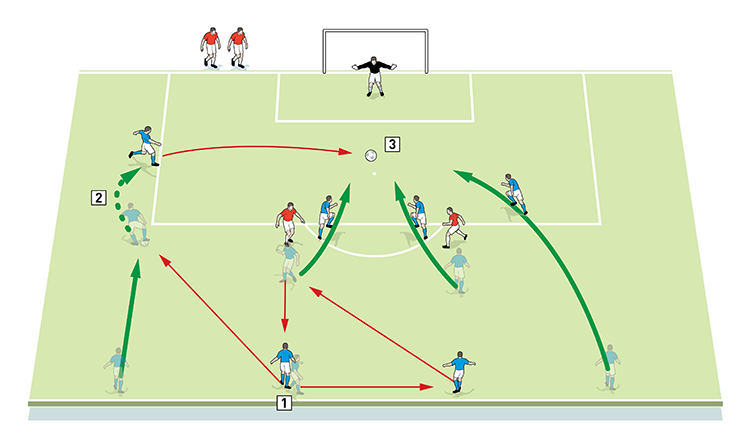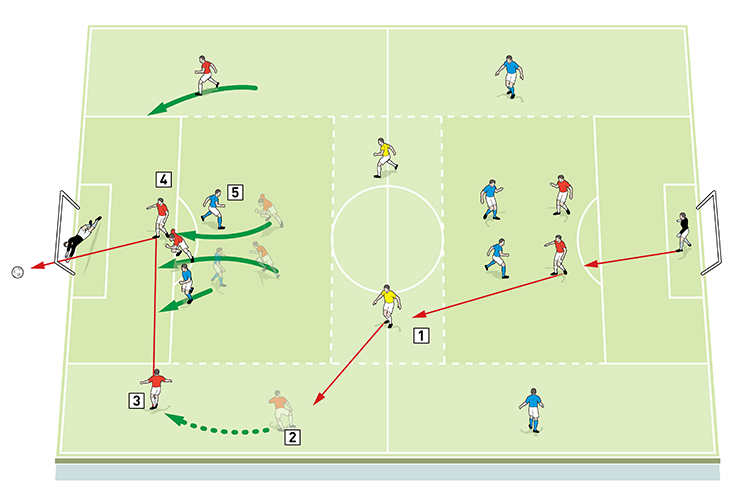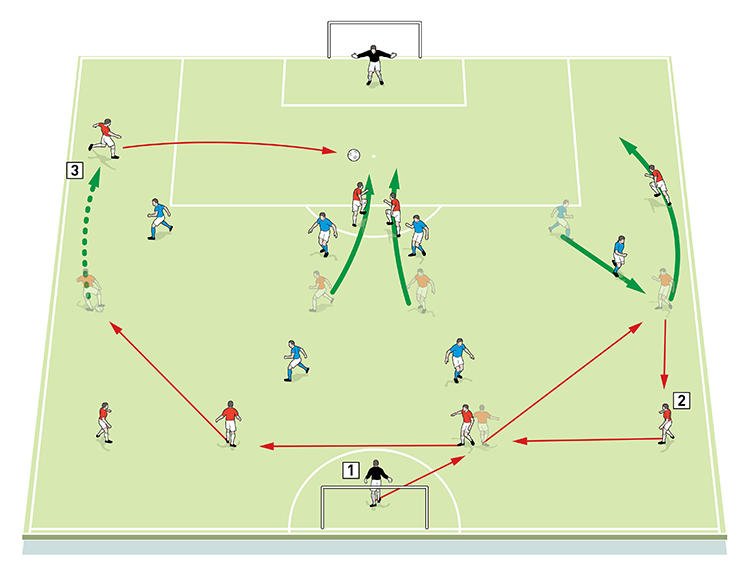You are viewing 1 of your 1 free articles
Creating scoring chances from wide
This session is designed to create plenty of goal scoring opportunities from wide areas when attacking in a 4-4-2 formation. Through repetition, it allows the forwards to work on attacking the penalty area in numbers and with well-timed runs.
| Area | Up to full pitch |
| Equipment | Balls, bibs, cones, 2 full size goals |
| No. of Players | Up to 14 players + 2 goalkeepers |
| Session Time | Practice 1: 15mins Practice 2: 15mins Progression: 15mins Phase of play: 20mins |
This session is designed to create plenty of goal scoring opportunities from wide areas when attacking in a 4-4-2 formation. Through repetition, it allows the forwards to work on attacking the penalty area in numbers and with well-timed runs.
Timing is the most important thing to be looked at, getting forwards to rehearse their runs so they are less likely to be picked up in the box by vigilant defenders. If their attacking runs are well-timed and creative, the forwards have a better chance of getting a shot on target. Success in this session also requires a variety of top class deliveries from the wide players.
What do I get the players to do?
Practice 1
We start with a semi-opposed session where there is only pressure on the attackers in the penalty area, leaving the wide players to focus on the quality of their crossing without coming under pressure from defenders.
We set-up in one half of the pitch, using 10 players and a goalkeeper, as shown [1]. The blues are the attacking team and they have two midfielders, two wingers and two strikers, while the reds are the defending team and have two active defenders (plus two resting defenders ready to rotate in when necessary).
1

2. The midfielder passes out wide to the winger, who is unopposed
3. As the ball is played into the box, the strikers make clever runs under pressure from defenders and try to score
The two blue central midfield players start the drill by combining to play the ball into a striker, who passes back to a midfielder. The midfielder plays the ball wide to a winger, who crosses to the two strikers, or to the opposite winger making a run to the back post. Look for these attackers to make clever runs, under pressure from the defenders, in order to meet the cross and try to get a shot on goal.
What are the key things to look out for?
The first thing to look out for is the quality of cross. It is imperative that it is of a high standard. It doesn’t matter if the cross is aimed at the front post, back post or penalty spot, but it must be firm and fast.
There are three main crossing options, depending on where the cross comes from: either around the back of the defenders, flashed low across a crowed penalty box, or floated over to the back post.
The second thing we look for would be the timing of runs from the three players entering the penalty area. As the ball passes through the box, the attacker must be ready to meet the ball. If he arrives in the area early, he needs to quickly recycle his run and make a movement to put himself behind the ball, allowing him the opportunity to attack the cross. It is the timing of the movement that makes the cross hard to defend against.
What do I get the players to do next?
Practice 2
For the next part of the session we move into more of a game-like situation, using the same coaching points and looking for the same outcomes. We set up on a full size pitch, with two unopposed wide channels for the wingers and a central zone the width of the centre circle for two neutrals, as shown [2]. We’re using 14 outfield players and two goalkeepers, divided into two teams of seven and two neutrals, who are the midfielders. Each team has a goalkeeper, two defenders, two strikers and two wingers.
2

2. The neutral midfielder must start an attack by switching play to a winger in the unopposed wide channel
3. Switching play is key to the success of the practice, creating space for the wide players to cross the ball
4. The strikers make well-timed runs into the box under pressure from the defenders
5. If the defenders win the ball, they can use the neutrals in the central zone as a target to play the ball to, starting a counter-attack.
The aim is for the team in possession to play out from the back and attack the opposition goal, using the neutral midfielders in the centre zone to quickly switch the play to the wingers in the unopposed wide channels. The strikers make runs to meet the cross and try to score, but if the defenders win the ball, they can use the neutral players on the halfway line as a target to play out to, starting a counter-attack.
To progress this practice, the midfield players in the central zone join the defending teams, one in each, as shown [3]. They can still be used to help switch play for the attacking team, but when a wide player makes a forward run down the wing, the centre player can now recover to help defend his team’s goal. In this progression, the wide channel is no longer unopposed and the defenders can now press the wingers.
3

2. When a wide player makes a forward run, the centre player can now recover to help defend the goal
3. The wide channel is no longer unopposed and the wingers can now be pressed
Phase of play
In the final phase of play, we set up on half a pitch with a goal and a goalkeeper at one end and another goalkeeper to act as a server at the other end. We’re playing 8v6 plus keepers, with the team of eight made up of two advanced full backs, four midfielders and two strikers. The team of six lines up with four midfielders and two defenders, as shown [4].
4

2. Look for players to switch play when space is tight on their side of the pitch
3. Players should cross from different angles, using either wingers or overlapping full backs to create the space for the cross
Play starts with the team of eight attacking. Coaches should encourage overlaps from the full backs around the wingers, with movement to create space for the cross. Coaches should also encourage setbacks to the full backs for them to cross from further out, and quick passing to get the ball wide, switching play when space is tight on their side of the pitch.
What are the key things to look out for?
We want to see a good first touch from all the players – it needs to be positive, giving us the ability to move forward with the ball on that touch or on the pass made with the second touch. Moving the ball quickly, coupled with good off-the-ball movement from the forwards, is vital to moving defenders and giving the attackers an advantage
Related Files
Editor's Picks
Deep runs in the final third
Using the goalkeeper in build-up play
Pressing principles
Intensive boxes drill with goals
Penetrating the final third
Creating and finishing
My philosophy
Pressing initiation
Compact team movement
Coaches' Testimonials

Alan Pardew

Arsène Wenger

Brendan Rodgers

Carlos Carvalhal

José Mourinho

Jürgen Klopp

Pep Guardiola

Roy Hodgson

Sir Alex Ferguson

Steven Gerrard
Coaches' Testimonials

Gerald Kearney, Downtown Las Vegas Soccer Club

Paul Butler, Florida, USA

Rick Shields, Springboro, USA

Tony Green, Pierrefonds Titans, Quebec, Canada
Join the world's leading coaches and managers and discover for yourself one of the best kept secrets in coaching. No other training tool on the planet is written or read by the calibre of names you’ll find in Elite Soccer.
In a recent survey 92% of subscribers said Elite Soccer makes them more confident, 89% said it makes them a more effective coach and 91% said it makes them more inspired.
Get Monthly Inspiration
All the latest techniques and approaches
Since 2010 Elite Soccer has given subscribers exclusive insight into the training ground practices of the world’s best coaches. Published in partnership with the League Managers Association we have unparalleled access to the leading lights in the English leagues, as well as a host of international managers.
Elite Soccer exclusively features sessions written by the coaches themselves. There are no observed sessions and no sessions “in the style of”, just first-hand advice delivered direct to you from the coach.









